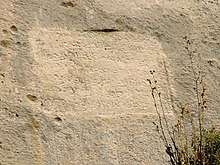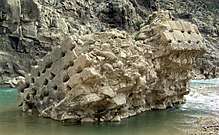Mihr Narseh
Mihr Narseh (Middle Persian: 𐭬𐭲𐭥𐭭𐭥𐭮𐭧𐭩 mtrnrshy), was a powerful Iranian nobleman from the House of Suren, who served as minister (wuzurg framadār) of the Sasanian Empire during the reigns of the Sasanian kings Yazdegerd I (r. 399-420), Bahram V (420–438), Yazdegerd II (r. 438–457) and Peroz I (r. 457–484).
Mihr Narseh | |
|---|---|
 Inscription of Mihr Narseh in Gor | |
| Born | 4th century Abruwan, Ardashir-Khwarrah, Pars |
| Died | 5th century Abruwan, Ardashir-Khwarrah, Pars |
| Allegiance | |
| Rank | |
| Battles/wars | Roman–Sasanian War (421–422) Battle of Avarayr |
| Children |
|
Etymology
The name of Mihr Narseh is a combination of the Middle Iranian theophoric names of Mihr (Mithra) and Narse(h).
Background
Mihr-Narseh was born in the 4th-century in the village of Abruwan in the rural district of Dasht-e Barin in the administrative division of Ardashir-Khwarrah, in southwestern Pars.[1] He belonged to the House of Suren, one of the Seven Great Houses of Iran. The family, of Parthian origin, had been active in Iranian politics since the Arsacid Empire, and held parts of Sakastan as their personal fiefdom.[2][3] It was thus unusual for a Surenid to be a native of Pars, which illustrates their extensive authority and influence during this period, which made them able to spread their influence to Pars, the homeland of the ruling Persian Sasanian family.[3] It is unknown if the Suren branch of Pars adopted the title of Parsig (Persian).[3] Mihr Narseh was the son of a certain Boraza, who may have owned the land Mihr Narseh was born in.[1] According to the medieval historian al-Tabari, Mihr Narseh traced his descent back to the legendary Kayanian king Vishtaspa and the first Arsacid king, Arsaces I (r. 247 – 217 BC).[1]
Career
In 453, Yazdegerd II moved his court to Nishapur in Khorasan to face the threat from the Hephthalites and left Mihr Narseh in charge of the Sasanian Empire. Mihr Narseh later retired in Pars.[1] He may have been succeeded by Suren Pahlav, another member of the Suren clan. He had three sons named Zurvandad, Kardar, and Mahgushnasp.
Constructions

In the early 5th-century, Mihr Narseh had a bridge built in Gor. An inscription was also written on the bridge, which says; "This bridge was built by order of Mihr-Narseh, wuzurg framadār, for his soul's sake and at his own expense... Whoever has come on this road let him give a blessing to Mihr-Narseh and his sons for that he thus bridged this crossing."[4] Furthermore, he also founded four villages with a fire-temple in each of them. The name of the fire-temples were; Faraz-mara-awar-khwadaya, Zurvandadan, Kardadan, and Mahgushnaspan. He had a fifth fire-temple constructed in Abruwan, which may have been the Barin fire-temple that the 10th-century Persian geographer Istakhri visited, who stated that the fire-temple had an inscription that stated 30,000 dirhams was spent for its construction.[1]
References
- Daryaee.
- Brunner 1983, p. 705.
- Pourshariati 2008, p. 64.
- Perikhanian 1983, pp. 661-662.
Sources
- Brunner, Christopher (1983). "Geographical and Administrative divisions: Settlements and Economy". The Cambridge History of Iran: The Seleucid, Parthian, and Sasanian periods (2). Cambridge: Cambridge University Press. pp. 747–778. ISBN 978-0-521-24693-4.CS1 maint: ref=harv (link)
- Daryaee, Touraj (2014). Sasanian Persia: The Rise and Fall of an Empire. I.B.Tauris. pp. 1–240. ISBN 0857716662.CS1 maint: ref=harv (link)
- Nersessian, Vrej (2018). "Persarmenia". In Nicholson, Oliver (ed.). The Oxford Dictionary of Late Antiquity. Oxford: Oxford University Press. ISBN 978-0-19-866277-8.CS1 maint: ref=harv (link)
- Sauer, Eberhard (2017). Sasanian Persia: Between Rome and the Steppes of Eurasia. London and New York: Edinburgh University Press. pp. 1–336. ISBN 9781474401029.CS1 maint: ref=harv (link)
- Pourshariati, Parvaneh (2008). Decline and Fall of the Sasanian Empire: The Sasanian-Parthian Confederacy and the Arab Conquest of Iran. London and New York: I.B. Tauris. ISBN 978-1-84511-645-3.CS1 maint: ref=harv (link)
- Daryaee, Touraj. "MEHR-NARSEH". Encyclopaedia Iranica.CS1 maint: ref=harv (link)
- Perikhanian, A. (1983). "Iranian Society and Law". The Cambridge History of Iran: The Seleucid, Parthian, and Sasanian periods (2). Cambridge: Cambridge University Press. pp. 627–681. ISBN 978-0-521-24693-4.CS1 maint: ref=harv (link)
- Pourshariati, Parvaneh (2008). Decline and Fall of the Sasanian Empire: The Sasanian-Parthian Confederacy and the Arab Conquest of Iran. London and New York: I.B. Tauris. ISBN 978-1-84511-645-3.CS1 maint: ref=harv (link)
- Gazerani, Saghi (2015). The Sistani Cycle of Epics and Iran’s National History: On the Margins of Historiography. BRILL. pp. 1–250. ISBN 9789004282964.CS1 maint: ref=harv (link)